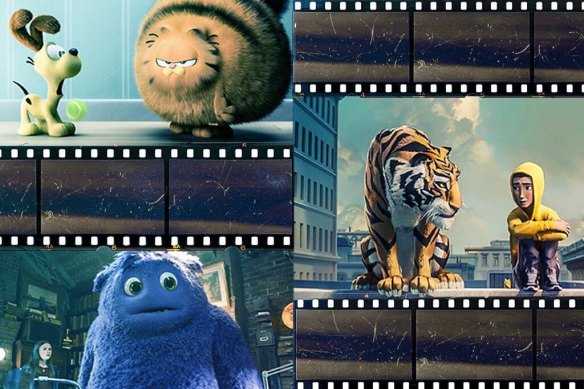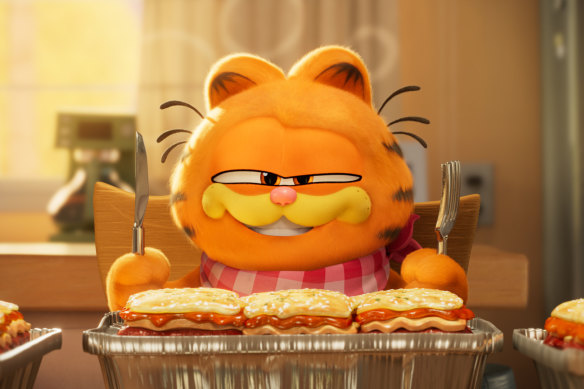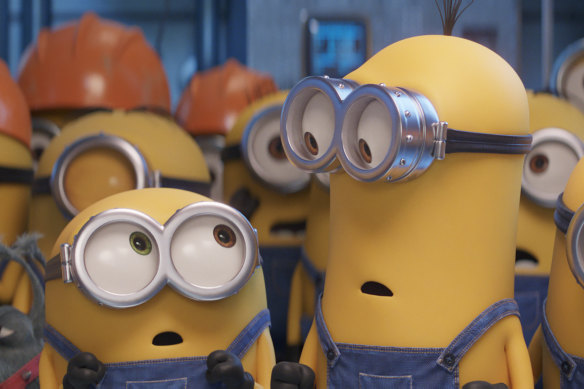
This year seemed like it would be a turning point for children’s cinema. After a relative dearth in family-friendly content, we were finally offered a sizeable slate of franchise favourites and completely original concepts – all released on the big screen rather than straight to streaming. And, for once in a long while, an embattled Disney studio would not dominate the line-up, with only three of the 13 major PG films this year.
It had every ingredient for triumph, except for… well, good movies. So far, practically every child-friendly film released has received middling, if not downright negative, reviews. Take The Garfield Movie, which premiered this week and was given a mere 1.5 stars by this masthead. Most other titles, such as John Krasinski’s IF and Kung Fu Panda 4, have languished between two and three stars.

From IF to The Tiger’s Apprentice: why are family-friendly movies not quite hitting the mark this year?Credit: Compiled by Bethany Rae.
That’s not to say they aren’t pulling in audiences – Kung Fu Panda 4, for example, grossed over $800 million worldwide. However, a strong box office doesn’t necessarily mean a film will stand the test of time. So, why are family-friendly films struggling to impress audiences, and what could this mean for the future of PG cinema?
A whole family affair?
Dr Jessica Balanzategui, an RMIT media and communications scholar who has researched children’s cinema, says major studios’ definition of “family-friendly” has shifted, potentially creating some confusion around who these films are actually for. Traditionally, a family-friendly movie would have something for every age while still being appropriate for children. In Shrek, for example, adults are free to laugh at various sexual innuendoes (like Lord Farquaad “admiring” a picture of Princess Fiona while seemingly naked in bed) while the children remain none the wiser. Meanwhile, older audiences sob throughout the climate change tale Wall-E while kids simply marvel at the robot’s cuteness.
Nowadays, however, Balanzategui says studios are releasing content that skews a lot younger, leaving tweens, teens and adults little to work with.
“It feels like we’re in a bit of a slump in terms of attempts to produce family films with a more traditional, light, child-friendly, comedic approach,” she says.
Take IF for instance, which sees a young girl try to reconnect forgotten imaginary friends with their former children. It’s certainly light-hearted and traditional enough, but it largely fails on the comedy front, becoming so clichéd and sweet it would give most adults a toothache. Similar could be said of Paramount’s The Tiger’s Apprentice, which charms with its unique animation style, but feels too derivative for parents and too schmaltzy for tweens and teens.
The tween problem
Part of the reason behind the studios’ shift towards more juvenile content is because tweens (between eight and 12) are becoming harder to cater to.
Loading
Djoymi Baker, a lecturer in cinema studies at RMIT, says this age group, which used to be a key demographic for family-friendly films, now tends to veer towards darker stories, including shows like Stranger Things or movies like M3GAN. Suddenly, the gap between what young children and slightly older children want has widened, making it practically impossible to appeal to all.
“The challenge of the family film remains achieving a balance between engaging elements for all ages, a commercial risk that can to some extent be managed by a straight-to-streaming release,” Baker says.
Streamers, as well as YouTube and TikTok, are where many tweens and teens access content these days. Given the sheer amount available on these platforms (and how easy it is to access), it’s posing a serious challenge to family-friendly films at the cinema.
“Taking a whole family to the cinema is a special event, but also an expensive one. And in the middle of a cost-of-living crisis, parents and other adult guardians are likely to be less forgiving of films that do not get the intergenerational balance correct,” Baker says.

The Garfield Movie may look the part, but it has received abysmal reviews from critics.Credit: Sony Pictures
This is also why many of today’s family-friendly films can sometimes feel like a mash-up of hyper-stimulating TikToks.
The number of quick-fire montages in The Garfield Movie (as well as blatant shilling of products, another TikTok staple), is enough to give you whiplash if you haven’t grown up consuming that kind of media.
You need only look at the fate of The Tiger’s Apprentice, which was scheduled for a theatrical release but ultimately went straight to streaming, to understand the strain multimedia platforms and wider industry fluctuations are placing on family cinema.
The IP safety net
Since production delays caused by the pandemic and the Hollywood strikes, most major studios have become more risk-averse and are relying on content with in-built appeal. Kristian Connelly, chief executive of Melbourne’s Cinema Nova, says family-friendly films are no exception.
Of the 13 family-friendly theatrical releases this year, eight are based on existing franchises. This includes titles like Despicable Me 4, Sonic the Hedgehog 3 and Mufasa: The Lion King. In other words, families are now less likely to be exposed to entirely new worlds, something many critics consider a loss.

The Despicable Me franchise is one of the highest-grossing animated film franchises ever, with more than $3.7 billion in tickets sold worldwide.Credit: AP
“There was a moment two decades ago when Pixar and early DreamWorks titles, such as A Bug’s Life and the initial Shrek titles, managed to thoroughly engage both children and adults, creating collections of modern original classics,” Connelly says. “But Hollywood is a business.
Shrek 2 made vastly more than Shrek, so it stands to reason that studios go back to the well until it runs dry, or voice actors become too expensive.”
Even some original concepts are jam-packed with A-list voice actors, drawing in audiences with major names, but arguably not delivering the goods. For example, IF features blockbuster stars like Maya Rudolph, Awkwafina, George Clooney and Matt Damon, yet their minuscule roles are almost inconsequential to the storyline, making it feel more like a marketing tool than a directorial choice.
The future is uncertain
Could some films released this year grow to become classics, like E.T. the Extra-Terrestrial or The Lion King? It’s too early to tell, Balanzategui says, but shifts in how families consume media could make it harder for contemporary films to stand the test of time.
Loading
“Earlier classics tended to … have a long-tail thanks to VHS rituals around family and co-viewing, but we don’t have much of a culture around physical home media any more. Disney+ has also made a few controversial decisions around removing both new and old family media from their platform, showing how we can’t really rely on streaming service catalogues to keep new family movies in the cultural zeitgeist for long.”
However, Connelly believes family-friendly films will persevere. After all, last year’s revenue came out strong, regardless of shifting appetites or negative reviews. “Collectively, all-age releases Barbie, Super Mario, Wonka, The Little Mermaid and Elemental grossed US$4.5 billion.”
Find out the next TV, streaming series and movies to add to your must-sees. Get The Watchlist delivered every Thursday.



























